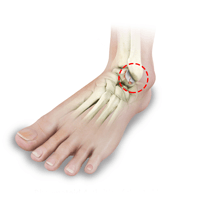Osteochondral Lesions
Osteochondral Injuries

Osteochondral injuries are one of the most common causes of ankle pain. Though in most cases there is a history of injury or trauma to the ankle joint, a few cases may not have any previous history of ankle injury. A condition known as osteochondritis dissecans is commonly seen in the knee and ankle joint and is characterized by the damage and separation of a piece of bone and cartilage within the joint from the underlying bone. In the ankle joint it mainly affects the talus bone and sometimes the lower end of the tibia or shin bone may also be affected.
Causes
The natural causes of osteochondral injuries are still not clear; however, injury to the talus bone, any local osteonecrosis or lack of blood supply to the bone or any metabolic defect may affect the bone and result in osteochondral injury. Sometimes recurrent ankle sprains may also result in osteochondral injury.
Symptoms
The predominant symptom of osteochondral injury is pain, which may be localized to the ankle joint. Other symptoms include tenderness and swelling of the ankle joint with difficulty in weight bearing. Some patients complain of locking of the ankle. In most of the patients it may also be associated with ligament injuries.
Diagnosis
Osteochondral injuries can be diagnosed by physical examination, X-ray and other advanced imaging techniques such as CT and MRI scan. Plain X-ray images will also demonstrate other fractures, bone spurs and narrowing of the joint. A CT scan helps identify any bony fragments and cysts, but is not very helpful to visualize bone edema (bruising) or cartilage defects. MRI is often the best imaging modality and helps to visualize the cartilage and the bone lesions as well as bone.
Treatment
Both non-surgical and surgical treatment can be used for the management of osteochondral injuries of the ankle joint. The non-surgical treatment may be used for small injuries and for rehabilitation purposes to improve muscle strength, mobility and coordination and protect the injured part by a brace or cast. Surgical treatment may be recommended for more severe injuries and includes arthroscopic debridement of the flaps of the cartilage and removal of any loose bodies. A cartilage restoration procedure is often performed in the same setting.
